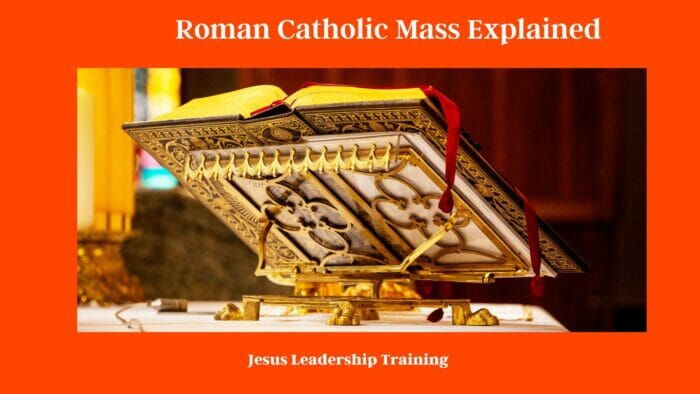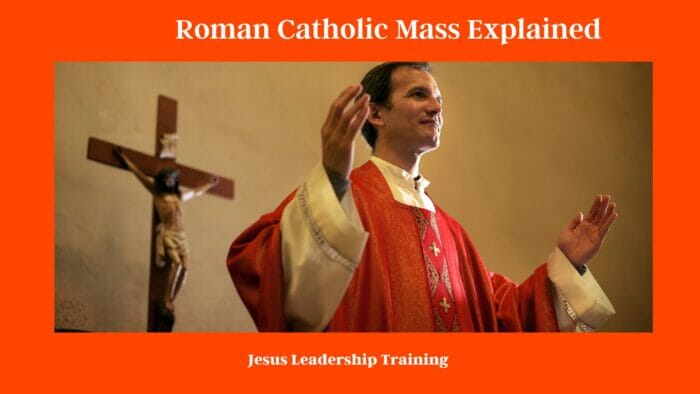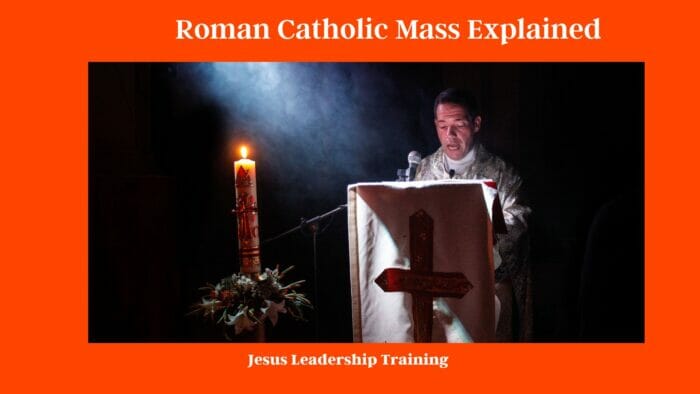In this comprehensive article, we will delve into the Roman Catholic Mass, its biblical definition, the four main parts, what happens during the Mass, how to explain it to non-Catholics, and final thoughts on this sacred ritual. Gain insights into the importance of God, reverence, communion, and more.
Roman catholic Mass is – Procession, Liturgy of the Word, Prayers, Communion, and Closing Admonitions.
Roman Catholic Mass Explained – The Roman Catholic Mass is a central and sacred ritual in the life of Catholics worldwide. It is a profound act of worship and devotion that has been practiced for centuries, carrying deep spiritual significance for believers.
In this article, we will explore the various aspects of the Roman Catholic Mass, from its biblical definition to the components that constitute this holy celebration. Whether you are a devout Catholic seeking a deeper understanding or a non-Catholic curious about this sacred tradition, join us as we unravel the beauty and meaning behind the Roman Catholic Mass.
Table of Contents
What is Roman Catholic Mass Explained?
At its core, the Roman Catholic Mass is a Eucharistic celebration, commemorating the Last Supper of Jesus Christ with his apostles before his crucifixion. During the Mass, Catholics believe that bread and wine are consecrated, becoming the true body and blood of Christ, an act known as transubstantiation. This belief in the Real Presence of Christ in the Eucharist lies at the heart of the Roman Catholic Mass, making it a deeply meaningful and spiritually enriching experience for the faithful.

Biblical Definition of Roman Catholic Mass
Importance of God
The Roman Catholic Mass places a strong emphasis on the importance of God in the life of believers. It serves as a way for Catholics to come together as a community and offer worship, praise, and thanksgiving to the Almighty. The Mass is a sacred encounter with the divine, providing an opportunity for spiritual nourishment and communion with God.
Reverence
Central to the Roman Catholic Mass is an atmosphere of reverence and awe. The solemnity of the Mass calls for respect, humility, and devotion. Catholics approach the celebration with a sense of deep respect for the presence of Christ in the Eucharist, bowing or genuflecting as a sign of reverence.
Communion
The act of receiving the Eucharist during the Mass is a moment of profound communion with Christ. It symbolizes a personal union with Jesus and his teachings, as well as with the entire Christian community. Communion is seen as a means of grace and spiritual nourishment, reinforcing the bond between believers and their faith.

Participating in a Catholic Mass involves several distinct steps, each with its own meaning and purpose. Here’s a basic step-by-step guide to what you can expect when attending a Mass:
- Arrival and Reverence: Arrive before the Mass begins. Upon entering the church, make the sign of the cross with holy water, genuflect (kneel briefly) towards the Tabernacle housing the Eucharist, then proceed to your pew.
- Introductory Rites: Stand when the priest enters. He will make the sign of the cross, to which everyone responds, and then greet the congregation.
- Penitential Act: The priest invites the congregation to acknowledge their sins and prepare themselves to celebrate the sacred mysteries. This is typically followed by the Kyrie (“Lord, have mercy”) and the Gloria, an ancient hymn of praise.
- Liturgy of the Word: Sit for the first two readings, usually from the Old Testament and the New Testament epistles, and the psalm response. Stand for the Gospel reading. Afterwards, the priest or deacon gives a homily (sermon), which is followed by the recitation of the Creed and the prayers of the faithful.
- Liturgy of the Eucharist: The priest prepares the bread and wine, prays the Eucharistic Prayer, and consecrates the Eucharist. This is the heart of the Mass, and the congregation participates through attentive listening and responses.
- Communion Rite: The Lord’s Prayer is said, followed by the Sign of Peace. Then the congregation forms a procession for Holy Communion. Catholics in a state of grace proceed to receive the Eucharist. Non-Catholics can go forward for a blessing, crossing their arms over their chest, or remain in their pews.
- Concluding Rites: After a brief period of silent prayer, the priest gives a final blessing. The congregation responds, and the Mass is concluded. The congregation remains standing until the priest has exited the church.
- Departure: Leave the church respectfully, aware that others may stay for private prayer.
These steps provide a general overview of the structure of the Mass, but practices may vary depending on local customs and specific liturgical seasons. Always follow the lead of the regular attendees and the instructions of the priest or other church leaders.
What are the 4 Main Parts of the Roman Catholic Mass?
The Roman Catholic Mass is divided into four main parts, each serving a distinct purpose in the celebration:
Procession
The Mass begins with a solemn procession, where the priest, accompanied by altar servers, deacons, and the congregation, enters the church. This procession symbolizes the community’s journey towards God and signifies the unity of the faithful in their worship.
Liturgy of the Word
The Liturgy of the Word involves the reading of sacred scriptures, including passages from the Old Testament, the Psalms, the New Testament, and the Gospel. The Word of God is proclaimed, and a homily, or sermon, is delivered by the priest, offering insights and reflections on the readings.
Liturgy of the Eucharist
The Liturgy of the Eucharist is the central and most sacred part of the Mass. It involves the consecration of bread and wine, transforming them into the body and blood of Christ through transubstantiation. The faithful participate in the Eucharistic prayer and the Lord’s Prayer, followed by the distribution of Holy Communion.

Conclusion
The Mass concludes with prayers of thanksgiving, a final blessing from the priest, and the dismissal of the congregation. This ending signifies a sending forth of the faithful to live out their faith in the world, carrying the grace and blessings received during the Mass.
What Happens at Roman Catholic Mass?
The Roman Catholic Mass is a structured and meaningful ceremony comprising several key elements:
Prayers
Throughout the Mass, various prayers are recited by both the priest and the congregation. These prayers include the Penitential Act, the Gloria, the Nicene Creed, and prayers of intercession for the Church and the world.
Readings
During the Liturgy of the Word, several readings from the Holy Scriptures are proclaimed. These readings provide spiritual guidance and inspiration to the assembled faithful, encouraging them to deepen their understanding of God’s word.
Sermon
The homily or sermon delivered by the priest offers insights into the readings and their relevance to the lives of the faithful. It provides practical applications of biblical teachings, helping the congregation to integrate these teachings into their daily lives.
Communion
The pinnacle of the Mass is the Liturgy of the Eucharist, where the bread and wine are consecrated, and Holy Communion is distributed to the faithful. This act of receiving the body and blood of Christ is a moment of profound spiritual communion and nourishment for Catholics.
How do you Explain Mass to a Non-Catholic?
Explaining the Roman Catholic Mass to someone who is not familiar with the faith requires sensitivity and clarity. Here are some key points to consider:
Reverence
The Mass is a deeply reverent and sacred ritual for Catholics. It is essential to convey that Catholics approach the Mass with respect and awe, as they believe it to be a direct encounter with the presence of Christ.
Prayers
Highlight the significance of prayers during the Mass, emphasizing that they are expressions of worship, gratitude, and petitions to God.
Humble
Explain that the Mass is an opportunity for Catholics to humbly acknowledge their dependence on God and seek His grace and mercy.
Remembrance
For non-Catholics, it may be helpful to compare the Mass to a communal remembrance of Christ’s sacrifice, where Catholics are spiritually nourished through the Eucharist.
When Can I ask Questions
| When | Where | How | Who |
|---|---|---|---|
| Anytime during office hours | At the parish office or rectory. Some priests may also have specific “office hours” when they are available. | By making an appointment. Call the parish office or speak with the priest after Mass. | Anyone who needs spiritual guidance, wants to confess sins, seek advice, or discuss personal matters. |
| Before or after Mass | In the church, usually near the altar or entrance. | Approach the priest directly, but be mindful if he is preparing for or concluding the Mass. | Anyone who has a quick question, needs a blessing, or wants to introduce themselves. |
| During Confession times | In the confessional or reconciliation room in the church. | Wait in line, if there is one, and then enter the confessional when it is your turn. | Catholics wishing to receive the Sacrament of Reconciliation. |
| In times of crisis or emergency | At your home, hospital, or wherever the need arises. | Call the parish office and request for a priest to visit. In many parishes, priests are on-call for emergencies. | Anyone in need of the Anointing of the Sick, Last Rites, or immediate spiritual guidance. |
| During parish events | At church gatherings, meetings, Bible studies, or social events. | Engage in casual conversation, or request to speak privately if there’s something specific you want to discuss. | Parishioners or attendees of the event. |
| Scheduled Spiritual Direction | Can be at the parish, the priest’s office, or a mutually agreed upon location. | Typically, a scheduled and regular time to meet for ongoing spiritual guidance. | Anyone seeking regular spiritual direction and deepening of their spiritual life. |
Please note that these are general guidelines and actual practices can vary by parish and priest. Always respect the personal boundaries and schedule of the priest. If a priest is not available, many parishes also have other trained pastoral staff who can provide guidance and support.
Final Thoughts
The Roman Catholic Mass is a profound expression of faith and devotion for Catholics around the world. It encapsulates the biblical definition of communion with God, reverence, and the Real Presence of Christ in the Eucharist. The structured four main parts of the Mass offer a cohesive and meaningful experience, emphasizing the importance of the Word and the Eucharist. For non-Catholics, understanding the significance of the Mass can provide insights into the heart of Catholic worship and the expression of faith in action.




